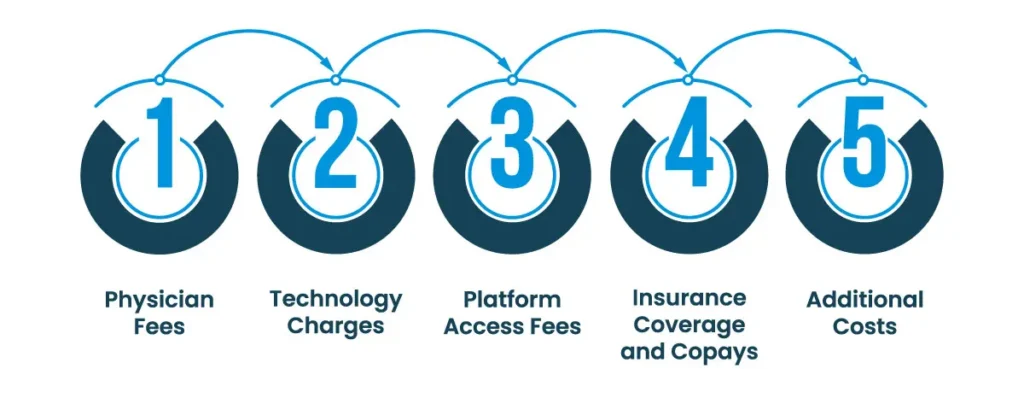

A recent study revealed that 40% of Americans avoid necessary healthcare due to affordability concerns. Telehealth emerged as a promising solution, but questions about its cost persist. Can virtual care truly offer quality healthcare at a reduced price?
In this blog, we’ll dissect the cost of telehealth, comparing it to in-person visits, uncovering potential savings, and equipping you with strategies to maximize your budget. Don’t let cost be a barrier to your health – Explore with us and discover if virtual care can fit your budget and healthcare goals!
While a 2017 study showed an average telehealth visit cost of $79 compared to $146 for in-person visits, current figures might differ. Costs can vary depending on factors. To help you get a better idea of how much telehealth costs we are unveiling the cost breakdown of the services as well keep reading.

1.Physician Fees: Just like in-person visits, the doctor’s time and expertise play a significant role in the cost. Factors like their specialty, experience, and consultation type (initial vs. follow-up) influence the fee. Remember, even though it’s virtual, their expertise remains valuable!
2.Technology Charges: The platform used for the telehealth appointment incurs costs. This could include fees for video conferencing software, secure messaging tools, and other functionalities used by the healthcare provider.
3.Platform Access Fees: Some platforms charge a subscription fee for patients to access the service. This fee provides access to a network of doctors and features like appointment scheduling and online medical records.
4.Insurance Coverage and Copays: The good news! Many insurance plans now cover telehealth services, similar to in-person visits. However, your specific coverage and copay will depend on your individual plan. Understanding your plan details is crucial to avoid unexpected expenses.
5.Additional Costs: Be mindful of potential add-on charges. These could include charges for prescriptions sent electronically, lab tests ordered through the platform, or additional consultations if needed.
Primary care: Telehealth shines for routine consultations as it helps to save more due due to shorter appointment times and lower overhead costs for the provider.
Specialty care: Savings vary depending on the specialty and complexity of the case. Telehealth consultations with specialists can be significantly cheaper than in-person visits, especially if the specialist is located far away.
Initial consultations: Telehealth is often cheaper for initial consultations, especially if they don’t require a physical exam. In-person visits might involve additional fees for initial assessments.
Follow-up consultations: Telehealth often shines for follow-ups, offering cost-effective solutions for managing chronic conditions or monitoring progress.
Urban areas: Both options might have similar costs due to higher provider fees and competition.
Rural areas: Telehealth can offer significant savings due to limited access to specialists and potential travel costs for in-person visits.
Factor | Telehealth Cost | In-Person Cost | Savings Potential |
Primary Care Consultation | $30-$75 | $75-$150 | 20-40% |
Specialty Care Consultation | Varies depending on the specialty | Can be significantly higher, especially for distant specialists | Up to 70% |
Follow-Up Consultation | $20-$50 | $50-$100 | 20-50% |
Travel Time & Parking | $0 | Varies depending on location and distance | Up to $50 per visit |
Childcare & Missed Work | $0-$100 per visit | Varies depending on individual circumstances | Up to $200 per visit |
Medication Refills | $0-$10 delivery fee | $20-$30 office visit fee | Up to $30 per refill |
Your insurance plan plays the starring role in determining your telehealth price tag. Here’s what to know:
Even with insurance, additional costs might come into play:
Efficient Resource Utilization
Reducing Travel and Related Expenses
Insurance and Payment Flexibility
Preventive Care and Early Intervention
Technological Advancements
Enhancing Patient Engagement and Satisfaction
Telehealth isn’t just about convenience; it’s about empowering you to take control of your health and your wallet. By understanding the cost breakdown, comparing options, and leveraging its unique advantages, you can unlock a world of affordable, accessible healthcare. Remember, telehealth isn’t a replacement for traditional care, but a powerful tool to complement it and bridge the gap to better health, one virtual visit at a time. So, why wait? Explore the possibilities of telehealth and discover how it can fit your budget and empower your well-being!
Talk to an Expert Now